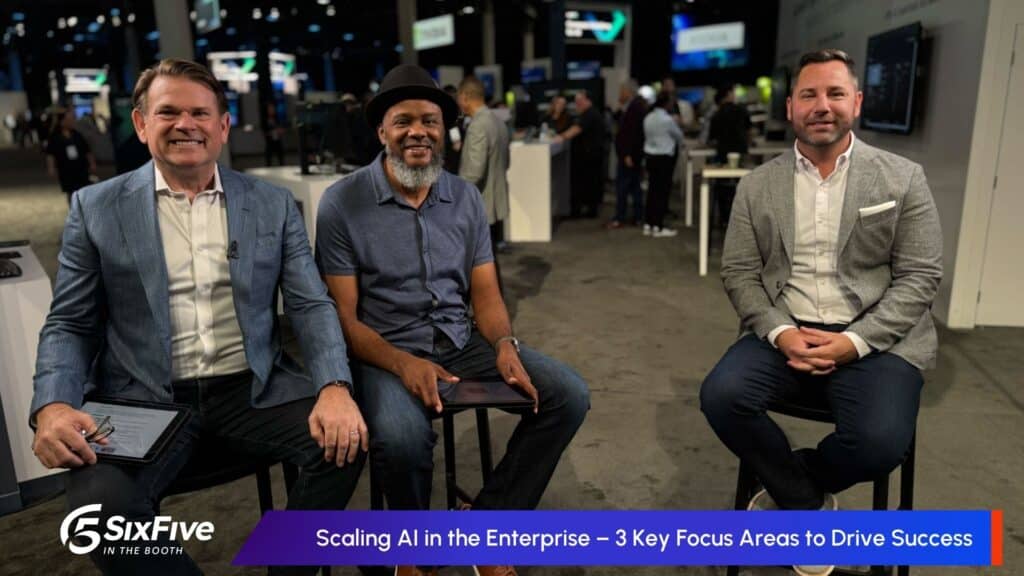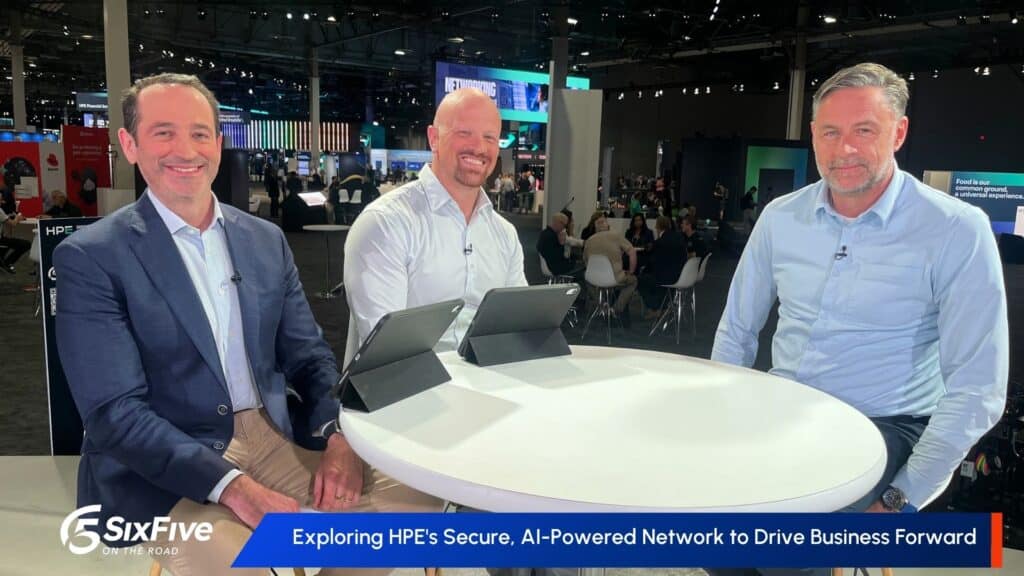On this episode of The Six Five – On The Road, hosts Daniel Newman and Patrick Moorhead welcome Jason Banta, Corporate VP and General Manager of Client OEM at AMD for a conversation on AMD’s AI PC vision, Ryzen AI processors, and the challenges and opportunities for the use of AI in business.
Their discussion covers:
- An inside look at AMD’s vision for the AI PC and what it can do for users
- What differentiates the Ryzen 8040 Series of processors from AMD
- The use of AI in business and what opportunities and challenges face business leaders and IT decision-makers today
- How AI adoption in the enterprise is evolving
Be sure to subscribe to The Six Five Webcast, so you never miss an episode.
Watch the video here:
Or Listen to the full audio here:
Disclaimer: The Six Five webcast is for information and entertainment purposes only. Over the course of this webcast, we may talk about companies that are publicly traded, and we may even reference that fact and their equity share price, but please do not take anything that we say as a recommendation about what you should do with your investment dollars. We are not investment advisors, and we ask that you do not treat us as such.
Transcript:
Patrick Moorhead: The Six Five is on the road at AMD’s Advancing AI event here in San Jose, California. Dan, it’s been an incredible event. There was a lot of the run-up to this event that got everybody tuned in and excited and it makes sense because there’s just this insatiable need and desire for AI and every part of the stack.
Daniel Newman: Oh, absolutely. And look, AI Hardware has been one of those things that’s been a headline-grabber all year. We’ve seen incredible runs for a very small subset of companies in the market and basically it’s been because just having any ability to deliver product was enough right now. But we are also seeing what’s I believe is going to be kind of that next wave where it’s going to be all about competition and innovation and ecosystem. And today really was the personification of that. But of course, we’re also seeing another wave, Pat and that other wave is in client and it’s going to be in the devices that we interact with and there’s a new profile of device that’s going to be really AI centric. And that was something that was talked about today too, that I thought landed really, really well.
Patrick Moorhead: It’s super exciting and it’s interesting. It’s just now starting to be cool to talk about it. Yet we’ve had AI on smartphones forever, primarily doing camera functions. And the cool part is that it’s coming to the PC and I can’t think of a better person to talk about it. Jason Banta, welcome to The Six Five.
Jason Banta: Thank you guys. It’s great to be with you today and talk about AI. I know we talked about AI a lot today. Talk a little bit more about it, but-
Patrick Moorhead: Can we ever get too much AI?
Jason Banta: You can’t say it too much, but we’re doing everything we can to drive it forward and keep advancing it. And so today we talked about the cloud, we talked about the server, we talked about the AI, PC and really everything we’re doing, and that’s a lot of what makes AMD unique is we can deliver AI in every type of solution. And so it’s great to talk about and talk about how we’re advancing it.
Daniel Newman: It’s a bit of a banter between Pat and I sometimes it’s how long a video goes before AI or general AI gets brought up. Every year we do our Six Five Summit. We’ve got all these different categories. It’s like 12 different categories. It’s edge and compute and then it’s been automotive and use of AI as a category, but now it’s going to be edge AI, compute AI, networking AI, automotive AI. There’s nothing else to talk about this year. So if you don’t put AI in the sentence, it’s like it doesn’t exist. It’s like there’ll, we’ll have a summit drinking game to say how many times did ever, anyway,
Jason Banta: I’ve seen this game before.
Daniel Newman: I digress.
Jason Banta: It doesn’t end well.
Daniel Newman: You know what it is. It’s been a really tremendous year, but one of the biggest topics, and Pat you and I have been on with a number of CEOs from the big OEMs that you supply, and it’s been next year, late next year, we’re going to have this AI PC. It’s the AI PC, it’s going to revolutionize. It’s going to be the next super cycle. First of all, just give us a little bit of the background, the run-up and what’s going on with AI PCs.
Jason Banta: Absolutely. AI PC is really an evolution of what we’re doing with AI. It’s bringing AI, it exists in the cloud today. It exists in the server, bringing it down into the end point, bringing it down into the PC, close to the customer, close to where they’re using it. And we do that in several ways. We do that in a hybrid fashion, sharing AI workloads between what’s happening in the cloud, what’s happening in the PC, but also local AI PC or local AI applications running on the PC on the laptop. And so bringing that in brings a lot of new capabilities. It enhances security. It enhances performance, efficiency. There’s a personalization that comes within a PC level, so it’s going to bring a lot of new experiences that is probably the biggest change in the PC that we’ve seen since the GUI came out. So it’s a big change for us.
Patrick Moorhead: I look at some of the applications that people are talking about and the processing of pretty much everything we do on our device. And I think even for some of the people who don’t care about privacy are going to be like, I don’t think I want to be transmitting that. And the speed of that and the speed of the interaction with that and the privacy in that is going to be super important. And there’s a couple waves of AI PCs that we’re going to see. Now, you brought out the Ryzen 8040 Series today. Congratulations. Can you talk about where that fits into the continuum of AI PCs and some of the differentiators that it brings?
Jason Banta: So earlier this year we launched our first AI PC solution 7040. We talked about that at CES. We’ve seen millions of those systems go into the market, great adoption of that. And that’s been good for both customers that want to use Ryzen AI, but also developers that want to develop on Ryzen AI. So having those solutions in market is great. With 8040, one of the big things we’re doing is enhancing the performance of that AI solution. So if you look at a 7040 relative to an 8040, it’s about 60% enhanced performance from an AI’s perspective. And that means running bigger models. That means running more models in parallel and enhancing the response of those models. So we brought that, we’ve got of the AI PCs in market. AMD is leading that with millions of those 7040 solutions in market. And we’re as those new applications, those AI applications get into market, we want to keep pace with that from a performance perspective. And that’s a lot of what the Ad-Forty’s about, which is going to be shipping very soon Q1 of next year.
Patrick Moorhead: That’s great.
Daniel Newman: Talk a little bit about the MPU. This is the thing that makes a PC, an AI PC, and obviously different companies are coming out with different metrics. You release some of your benchmarks and the numbers, it’s going to expand, no question, you’re going to go generation to generation. It’s going to continue to improve. Why are those, first of all, what is the metric that you’re focused on and why is that important for people to get that AI PC experience? Because I still think when I pick up, we’ve played with some of these, we’ve seen the prototypes, it still looks like a PC. It hasn’t changed. It’s kind like when you went to ChatGPT, it looks a little different than Google. It functions a little different. For people, a lot of people though, it’s like, maybe there’ll be a magic button on it, but overall it’s like we don’t know it’s an AI PC. What’s that kind of thing, that experience and that measurement that makes something really an AI PC?
Jason Banta: So you talk about the MPU, that is a specific hardware we build into our chips and our solution that is built for AI instructions, AI workloads, and that exists on a number of our notebooks today. So its purpose built for that, and it allows us AI applications to run efficiently and run at a high level of performance. So you need that dedicated hardware. The PC today, it does look very similar, but that’s going to evolve. What AI’s going to bring is new ways to interact with the PC. The PC today you see the keyboard and mouse, but what AI is going to enable is much more natural interaction with the PC over time. It’s going to get much more personal. It’s going to include voice, it’s going to include video. A lot of those things are going to come into the PC and make it much more easy to interact with it. And the way the PC is going to respond to what you want to do is going to get much more personal. So there’s an evolution that’s happening and it’s going to change those applications first, but then the form factor’s going to evolve with it as well.
Patrick Moorhead: So you showed a combined TOPS number, and I think that’s maybe the simple way that we measure, which is the overall TOPS delivered by the CPU, the GPU, and the MPU, and then the key becomes getting ISVs to sign up and write to it and determine the best way to leverage that to stay within the thermal envelope of the solution. I’m curious, how are you enabling that software for developers, whether they be consumer ISVs or even enterprises? And we’re going to talk a little about enterprise later.
Jason Banta: So you’re right. The way that the developer approaches an AI PC is very important. So what hardware do they optimize for? Our approach is really down to three big pieces. One is a deep partnership with Microsoft. They’re obviously a predominant ISV in the market, and they’re leading a lot of what’s happening in AI PC, deep partnership with Microsoft. We’ve got very critical partnerships with big ISVs, some of the larger content creation applications, those big software houses that are established in the enterprise, they’re established with consumers. So partnering with those ISVs. And then we’re also doing something very unique, which is we’re opening up our software such that everybody can get access to it. So today, in addition to the 8040 series, what we launched with Ryzen AI, we also opened up a software suite that makes it much more accessible such that developers of any size can jump in, start developing on Ryzen AI. It’s very turnkey for folks to get started. Existing models that are out there on hugging face or other places, you can find those open source models. They can get started with those right away. So we’re trying to democratize it in that sense. So those are the three big pillars to how we’re enabling the ecosystem.
Patrick Moorhead: Appreciate that.
Daniel Newman: So let’s make a last stop. Today was very enterprise-centric, but a lot of the enterprise is focused on the cloud and the LLMs, but the PC is critical to the commercial experience for business. And we’ve seen a few of the applications. You mentioned Microsoft and that partnership. Obviously the whole world is seeing the co-pilot, but how are you kind of seeing that play out? Because I believe the biggest user for the AI PC, at least the one that’s going to really take off is going to be actually the enterprise user. But I’ve been trying to think about what are the applications, what are you seeing? You’re talking to the ISVs, you’re partnering with all these companies. How does this play out? How quickly does it evolve? And are those timelines we’re hearing from all these OEMs? Are you seeing the same thing again, not asking you to call it, just want to get your take?
Jason Banta: There’s a lot happening right now. So calling it precisely is tough, but I tend to agree the enterprise is where you’re going to see lot of, it’s a lot of benefit from what we’re doing as an industry with AI PCs. AMD And others as an industry doing that. The enterprise is really where you’re going to see productivity gains from this. So making a lot of mundane tasks that you would do on a PC today, automating those, making those simpler, making the PC much more personal. So understanding how you like to do your daily tasks or whatever, bringing that advancement in there and then enhancing the efficiency of it is going to be a big part of that as well. One of the other big pieces, I think, unique to the enterprise is the AI PC is going to help enterprises with their costs. So doing AI applications in the cloud today, it is an expensive endeavor for CIOs, for ITDMs. And bringing those capabilities into the PC takes a lot of that off of what exists in the cloud, what the server deployments they have to think about. So there’s a cost element to it as well. That’s very important for enterprises to think about as they look at deploying AI PCs versus non-AI PCs.
Patrick Moorhead: So great conversation. I want to talk about the roadmap. So not only did you announce the 8040 series, but Lisa also flashed the roadmap.
Daniel Newman: Further out there.
Patrick Moorhead: And again, if you can talk a little bit about that and kind of how this is in the continuum over time. You had the 7040, you have the 8040, and obviously everybody will have a next generation, but what are some of the design principles that you’re looking at for that next generation after the 8040?
Jason Banta: So we talked a little bit about what’s next. We talked about Strix Point, we talked about XDNA 2, which XDNA is the architectural name we have for that MPU. So we talked about the next generation of that. So big performance enhancement generationally, it’s going to light up a lot of larger models, newer models. It’s a big jump relative to the XDNA solution. And a lot of the way we’re thinking about that architecturally are concepts from a design perspective, again, back to close partnership with Microsoft on what’s coming next, what those key end-user experiences are going to be, building around that to making sure we’re architecting that correctly. And then we’re also learning from the feedback. One of the advantages of having AI PCs in the market today is we’re getting feedback from enterprises or from consumers that are experimenting with it. We’re getting that feedback and it’s evolving how we’re doing that next generation. So greater performance, greater efficiency, and enabling new experiences that next wave of AI PCs in the market.
Patrick Moorhead: Appreciate that.
Daniel Newman: Well, Jason, I want to thank you so much for joining us here on The Six Five. It’s been a very promising day for AMD.
Jason Banta: I don’t know how many times we said AI, but I think it was plenty.
Daniel Newman: I think we hit it. I don’t know if there was a quota, but we got there.
Patrick Moorhead: I can’t wait to get seeding AI PC. There we go, another one.
Daniel Newman: I’m going to ask him to send me an AI PC prototype really soon, Jason.
Patrick Moorhead: That’s smart of you, AI.
Daniel Newman: Thanks for joining us.
Jason Banta: Dan, Pat, thank you.
Patrick Moorhead: Thanks.
Daniel Newman: All right, everybody hit that subscribe button. Join us for all of our coverage and analysis here at AMD Advancing AI in San Jose. It’s been a great event. It’s been nice to have you with us and we hope you’ll come back really soon. But bye for now.
Author Information
Daniel is the CEO of The Futurum Group. Living his life at the intersection of people and technology, Daniel works with the world’s largest technology brands exploring Digital Transformation and how it is influencing the enterprise.
From the leading edge of AI to global technology policy, Daniel makes the connections between business, people and tech that are required for companies to benefit most from their technology investments. Daniel is a top 5 globally ranked industry analyst and his ideas are regularly cited or shared in television appearances by CNBC, Bloomberg, Wall Street Journal and hundreds of other sites around the world.
A 7x Best-Selling Author including his most recent book “Human/Machine.” Daniel is also a Forbes and MarketWatch (Dow Jones) contributor.
An MBA and Former Graduate Adjunct Faculty, Daniel is an Austin Texas transplant after 40 years in Chicago. His speaking takes him around the world each year as he shares his vision of the role technology will play in our future.










